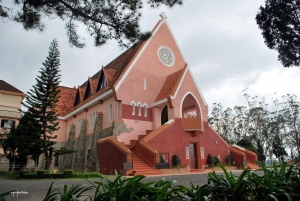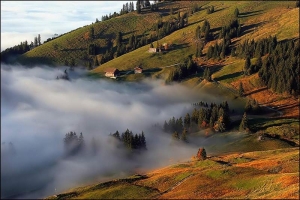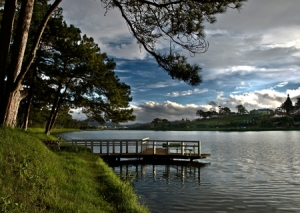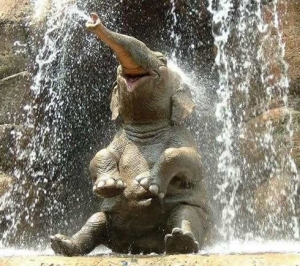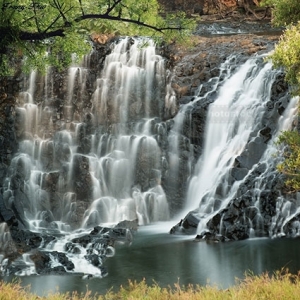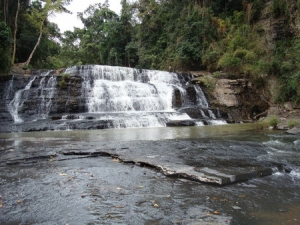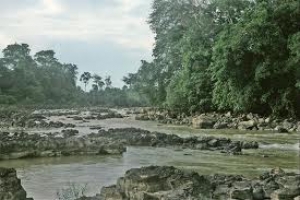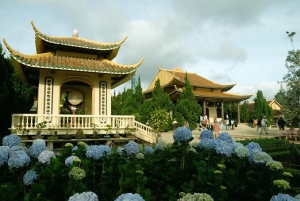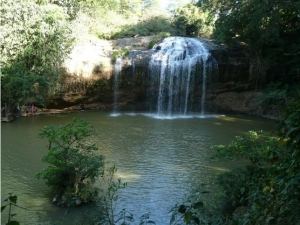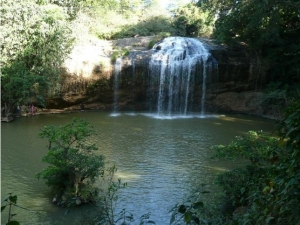
Asia Pacific Travel Team
Domaine de Marie Church- The Harmonious Combination of Western and Eastern Architectural Style
No one can deny the reputation of Dalat as one of the most attractive cities in Vietnam, which can be accounted for by the fact that its architecture was the perfect combination of French and Vietnamese style. The Domaine De Marie (Dominion of Marie) Church is one example of that interaction between the two cultures. Today, it is not only a place for the local people to worship but also a destination for visitors to Dalat from just anywhere.
The Domaine de Marie Church is home to the Roman Catholic nuns of the Mission of Charity. Located not far from the city center, the church in Dalat is a 29.6-acre architectural complex consisting of the main church and two convents. The church was built from 1930 to 1943 following the 17th century French style. However, because its architecture is the harmonious combination of Western art and Vietnamese folk art, the church definitely stands out from other ones created at the same era.
The facade of the building is designed as an isosceles triangle with many small arch-shaped windows, and a cross on the top. Right at the center of the facade is a grand rose-shaped window, a detail which usually appeared in the architecture of French church at the end of the 17th century. The walls are decorated with the Normandy style which allows creative manipulation of lights: dark-bright, solid-hollow, etc. however, the Vietnamese part does not subside.
The Vietnamese arrangement of this church makes it special and different from the classical churches of Europe. The roofs of the church have their origin from the design of Nha Rong (Dragon House), a typical type of stilt house in Central Highland of Vietnam. Even though the huge and steep roofs look pretty bland, the elegant stained glass windows make them a work of arts and illuminate the interior of the Domaine de Marie Church. The statue of Marie is another example of the interaction. It is created by a French architect named Jonchere in 1943, but resembles the image of a Vietnamese woman. In general, though the combination of the two competing styles might seem unusual, it creates an absolutely creative and intrigue complex.
If tourists in Vietnam travel need a change of the mood for in a Dalat trip, which is always assumed to be romantic and peaceful, makes sure to pay a visit to Domaine de Marie to worship and experience the intersection of French and Vietnamese art.
The Little Paris of Vietnam- Valley of Love- Dalat- Lam Dong
Compared with the true love which has to surpass several obstacles, the Valley of Love in Dalat had to surpass many challenges in the past in order to gain its rightful name as today. In the beginning, the valley was called Vallée D’amour (Valley of Love) by the French before being renamed The Valley of Piece. In 1935, its beauty and captivation persuaded people to once again name it after the most wonderful thing in the world: Love.
The Valley of Love today is located 4 miles away from the center of Dalat which is considered as the little Paris. Throughout history, it has been one of the most picturesque and romantic sites of Dalat city, with many deep valleys and endless pine forests. The tranquil Da Thien Lake, which was created in 1972, also adds a great deal to the attractiveness of the valley. To truly appreciate the sceneries is not hard because travelers can easily follow the natural tracks and staircases all around the valley to visit and admire the gorgeous flower gates and statues.
The tracks lead to Vong Canh Hill from which the magnificent view in the Valley of Love gradually appears in each tourist’s eyes. From that hill, they can also see the Langbian peaks standing out vividly against the blue sky, or continue their adventure to find the Paradise Hill, another ideal destination which is surrounded by beautiful lakes. Overall, the valley is another wonderful addition to your trip to the romantic Dalat.
Does it sound like a great rendezvous to say your marriage proposal? Not really, because anyone can possibly fall in love with the landscape before fully listening to what you say. But in case you are really making a proposal, give it a shot. Even if she/he refuses you, at least you will have been to The Valley of Love.
If tourists in Vietnam travel want to make a tour to Dalat, a rhythmic land of flowers and romance, you should add the Valley of Love to your itinerary because it is a wonderful destination for those who love a romantic trip.
Xuan Huong Lake- A Symbol of Romantic City on Central Highlands-Dalat City
Used to be the site in which many indigenous people of Langbian highland inhabited, this man-made lake is nowadays the most beautiful lake of Dalat, becoming a symbol whenever people mention Dalat city, Lam Dong province.
Unlike others, the history of Xuan Huong Lake distinguishes it as one of the most special lakes in Vietnam. In the past, there was no lake where we see Xuan Huong Lake today. In 1919 and 1923, two dams were formed on a branch of Cam Ly River to create two small lakes. Unfortunately, during a severe storm in 1932, both dams were destroyed. Between 1934 and 1935, a larger dam was built of boulders below the sites of the two previous dams to create one large lake. At that time, the French named it Grand Lac (large lake), but in 1953 it was renamed Ho Xuan Huong (Xuan Huong Lake) to express the people’s appreciation to the famous Vietnamese poetess in the 19th century who has the same name.Looking from above, Xuan Huong Lake is like a crescent moon which extends to approximately 1236 acres. The surface of Xuan Huong Lake is as smooth as a mirror reflecting the romantic scenery of Dalat with pine forests, meadows and gardens. Nowadays, visitors can enjoy not only strolling along the lakeside but also resting under the conifers, pedal-boating on the lake while admiring the spectacular architecture of Thuy Ta pavilion. As a major attraction in Dalat, Xuan Huong Lake is a place for people from both inside and outside the city to meet, talk and fall in love.
Therefore, tourists in Vietnam travel don’t need to be on honeymoon to visit this wonderful place, just come and and let the beauty of Xuan Huong Lake inspire you.
Elephant Waterfall- A Rare Landscape Waiting for Natural Lovers' Discovery
Elephant (Voi) Waterfall is located about 25 kilometers southwest of Da Lat City of Lam Dong Province in Nam Ban Townlet, Lam Ha District. This waterfall, also called Lieng Rowoa Waterfall, is considered as the most beautiful and majestic waterfall in the highlands province of Lam Dong. It is more than 30m high, about 15m wide with the water flows make an area be obscured by the very white spray.
It is unfortunate that if you visit Da Lat - Lam Dong you do not visit the secret and dreaming of Lieng Rowoa Waterfall (Voi Waterfall). The waterfall appears as many elephants are swimming together.
According to local legend, the name of the waterfall is derived from a folk story about a beautiful girl, the daughter of the head of a tribe in Joi Bieng mountain region, who had an excellent voice, when she sang the foliate seem to stop rustling, the bird stop singing to listen to her. She had promised of becoming spouse with a handsome, brave and strong young man, the son of the head of a tribe in the neighbour region. But one day, the young man must say good bye to his lover to be fighting at the front. She waited for long time but the young man did not come back. She went to the place where they made the promise before and began singing with ardent and mournful voice. The B'ling birds had been moved by her voice. They flied far away to seek out information and then flied back to inform her that the young man had died in the battle. However, the girl did not accept this bitter truth and she sang to call her lover until she get exhausted and falling down. The flock of elephants that had lied prostrate to listen to her turned into stone. The waterfall named Lieng Rowoa Joi Bieng, means the waterfall of elephants that lied prostrate turned into stone before the ardent and faithful love.

The waterfall which associated with this faithful, woeful and majestic love has been recognized as a national landscape. The transparent water flowing through granite mountain sides looks really spectacular, especially when the waterfall is illuminated by the brilliant sunlight, seven-coloured rainbow will appear.
Next to the waterfall is Gio (wind) Cave. The road to enter the cave is narrow between two cliffs, but inside the cave there are many wide spaces and full of wind. Voi Waterfall looks like a lively picture which has been carved by nature with the particularly interesting caves hide after craggy cliffs and many rocks now appear, now disappear look like as many elephants are jostling to bath. At the foot of the waterfall stream there are many large, flat and smooth stones like the nature set up to offer tourists sit to chat.
Voi Waterfall is waiting to be discovered by the natural lovers. The waterfall is still keeping the original's features. Some guest houses, tourist clubs, some poetic bridges are looming in the deep eyesight. Every year, the Voi Waterfall welcomes thousands of visitors in Vietnam travel. If you are the people who like wild, quiet, go to this place to contemplate the hills and mountains, pine forests and rocky waterfalls.
A pristine and poetic beauty at Dieu Thanh Waterfall
Ba Tang waterfall (Three layers waterfall)
In Dak Nong province there are many waterfall such as Ba tang, Gialong, Trinh Nu, Dieuthanh waterfall, all of which have natural beaty, covered green forests. Of those waterfall, Ba tang is ideal place for bathing, picnicking, exploiting natural landscapes.
Three layers( Ba tang) waterfall is a beautiful landscape of Dak Nong province. It is approximately 8km from Gia Nghia town on the orient of Buon Ma Thuot. It is named Ba Tang (three layers) because the spring water flows through three layers of waterfall before coming to the main spring.
These three layers are linked 40m in length. The first layer is not so high. Water from the rocks fell down on 1.5m in hight. The height from the first to second layer is about 20m. Water in this layer are very pure and green to flow among the interposing rock blocks and coming down to let go the dazzling white bubbles. The last layer is the biggest waterfall, which is the main one of the group Ba Tang waterfall.
The main waterfall is about over 20m tall, it rumbling flows all day long in the middle of quiet landscape and flows to the two banks of the spring. The spring here is quite big with the high trees along two sides. Visitors with Vietnam travel guide would just enjoy the landscape in the height with the sounds of the water scheme. Standing in the underneath, the waterfall could be seen with the steam flying around which is like a fog around the waterfall.
Nearby the Ba Tang waterfall, there are lots of ancient trees and plain grass ground, which is suitable for camping trips and picnics. Along with Dieu Thanh waterfall, Ba Tang waterfall is the camping tourism place that is has much delight in the South of Daklak.
Cat Tien National Park- A Great Eco-tourism Destination in Vietnam
Driving along National Highway 20 from Ho Chi Minh City to Dalat, turning left about 24 km at Milestone No.174, Tan Phu cross-road; you will reach Cat Tien National Park. Belonging to three provinces of Dong Nai, Lam Dong and Binh Phuoc, Cat Tien National Park is one of the most important national parks in Vietnam.
Covering a large area of more than 71,920 ha, the park is divided into three main sectors. The South of Cat Tien (Dong Nai Province) is 39.627 ha; Cat Loc (Lam Dong Province) 27, 8521 and the West of Cat Tien (Binh Phuoc Province) is 4,443ha. In 1978, the South Cat Tien and North Cat Tien parks were put under the State's protection. However, due to the classification of Cat Loc Park in the program for the protection of natural wild animals and flora, in December 1998, these three parks joined together to become the Cat Tien National Park, under the management of the Ministry of Agriculture and Rural Development.
The topography of Cat Tien National Park varies greatly among the three sectors. The Cat Loc sector is situated at the western extent of the Central Highlands and, consequently, is rather hilly. Although elevations only reach 659m, the hills are relatively steep. In contrast, South Cat Tien and West Cat Tien sectors are situated in the lowlands of southern Vietnam, at the foot of the Central Highlands. The topography of these sectors is characterized by low, gentle hills; the highest one reaches an elevation of 372m.
Dong Nai River - the second largest river in Southern Vietnam - flows through the national park, forming the western boundary of the Cat Loc sector and the eastern boundary of the South Cat Tien sector. The lowlands in the north of the South Cat Tien sector are poorly drained, and support an area of swamps and lakes, which are fed by seasonal flooding of the Dong Nai River.
Cat Tien National Park gathers the diversity of fauna and flora typical for ecosystem of wet tropical forest in the provinces in South East of Vietnam. The park is estimated as the reserve of natural resources in Vietnam with lots of rare, specious and endemic genes of fauna and flora, as plentiful site for scientists, domestic and foreign tourists.
Let’s come into the forest on a trail covered with tree leaves. The sunshine was on the canopies, layer after layer, the air was humid. The cicadas resounded over the forest. Don't forget to see a 400-year-old conifer there. Going further, you can see another tree, called bang lang, which is almost 300 years old. There are many other strange trees in the forest: a red-wood tree having a diameter of 3.7m, a fig having a fasciculate root that runs along the stream and can shade about 20 people, a banyan tree having a hollow trunk which is large enough for 3 people. So far, in Cat Tien Park, 1,610 kinds of flora have been classified which belong to 75 species, 162 families and 724 branches, many of them listed in the Red Data Book of Vietnam.
Covering an area of 74,319ha, the Cat Tien National Park has preserved its original natural soil with a diverse ecological system and many rare and valuable species of animals listed in the Red Book of Endangered Animals.
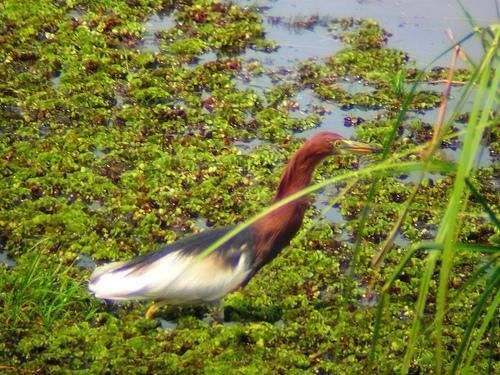
To date, 76 mammals, 320 birds, 74 reptiles, 35 amphibians, 99 fish and 435 butterfly species have been confirmed to occur at the National Park; and there are unconfirmed records of an additional 32 mammals, 19 birds, 9 reptiles, 4 amphibians, 31 fish and four butterfly species. The park comprises of such impressive mega fauna as Javan Rhinos (only one of two populations in the world), Asian Elephants, Gaur, Sun Bears and, possibly, Banteng, and wild Water Buffalo.
Cat Tien National Park is part of the wet tropical forest complex and one of the specious natural forests remaining in Vietnam. That is why this area is significant not only in Vietnam but in the world as well. The diversity of the Park has been recognized by WWF when this international organization selected the Park as one of 200 global ecological zones including the land and its water area with its well-known biological diversity. In 2001, Cat Tien National Park has been listed by UNESCO as the 411th biosphere Reserve Zone in the world.
 Cat Tien is one of the most important sites in Vietnam for the conservation of large mammals. Among the large mammal species that have been confirmed to occur at the national park are Asian Elephant Elephas maximus, Lesser One-horned Rhinoceros, Eurasian Wild Pig Sus scrofa, Sambar Cervus unicolor and Gaur Bos gaurus, of which the later three species reportedly occur at high densities relative to other areas in Vietnam. The park is harboring the last known population of Javan rhinos in mainland Southeast Asia. Many projects are addressing a number of threats by strengthening law enforcement, habitat management and rationalizing park boundaries following the completion of several ecological and socio-economic studies. At the same time, these projects assist people living in the park's buffer zones with small scale community development activities.
Cat Tien is one of the most important sites in Vietnam for the conservation of large mammals. Among the large mammal species that have been confirmed to occur at the national park are Asian Elephant Elephas maximus, Lesser One-horned Rhinoceros, Eurasian Wild Pig Sus scrofa, Sambar Cervus unicolor and Gaur Bos gaurus, of which the later three species reportedly occur at high densities relative to other areas in Vietnam. The park is harboring the last known population of Javan rhinos in mainland Southeast Asia. Many projects are addressing a number of threats by strengthening law enforcement, habitat management and rationalizing park boundaries following the completion of several ecological and socio-economic studies. At the same time, these projects assist people living in the park's buffer zones with small scale community development activities.
A major conservation education campaign will raise awareness and promote a conservation agenda in the wider landscape so that the park's ecological links with surrounding protected and unprotected forests are strengthened.
Tourism activities
Cat Tien National Park receives a growing number of tourists in Vietnam travel; many of them visit on day or weekend trips from Ho Chi Minh City. The national park is also gaining in popularity amongst specialist foreign tourists, including birdwatchers. The proximity of the national park to Ho Chi Minh City - its location on the route between Ho Chi Minh City and Da Lat city, the well developed tourism infrastructure at the site, and the ease at which wildlife can be seen relative to other sites in Vietnam, are all factors in favor of growth in the tourism sector.
Visiting Dalat Truc Lam Zen Monastery in Vietnam Tourism
On the way from National Road 20 to Tuyen Lam Lake, tourists in Vietnam travel have to run right onto a zigzagging tar road at the mountain side to Phoenix Summit, on which stands beautiful famous Truc Lam Zen Monastery in an open poetic natural environment. Established in special social conditions, with the aim of restoring Truc Lam Yen Tu Xen School founded by the King Tran Thanh Tong, this Zen school has harmoniously combined different Zen schools with Vietnamese culture and tradition into Vietnamese Zen. Truc Lam Zen Monastery lies on a protected forest of 23,2 hectares, of which 2 hectares is the building area.
Besides the Main Hall in the middle, on the right are the consulting room, the belfry and displaying room on the right; on the left are the sitting room, library, abbot’s room and contemplation hall. Before reaching the Main Hall, tourists may take two ways. They may start at the bus stop, take the side gate up 61 steps or, from the lake, climb the 222 steps through the triple gate onto the court in front. Inside the Main Hall, statues are displayed simply but meditatively. In the bright spacious sanctuary is the only statue of Sakyamuni Buddha raising a lotus in his hand – a symbolic image of Buddha in Linh Son Dharma Conference, expressing the philosophy of ‘existence in nihilism’ in Buddhist Zen.
Zen helps you to live in "full awareness" and bring your soul back into peaceful state. Truc Lam Buddhist Zen emphasizes on every one’s interior concentration, either a religious or someone in your family. This introspective soul training process leads to personal purification, builds a care-free mind and help one’s good nature to show up; this is the real peace in everyone’s interior, not in a certain paradise in a faraway world.
Thus, visiting Truc Lam Zen Monastery in the quietness of hills and mountains, tourists in Vietnam travel are free from everyday worries and seem to be able to regain themselves in the greatness of the nature.
Prenn Waterfall- A Popular Sight in Dalat
Prenn Waterfall is situated right at the foot of Prenn Pass, 10 kilometers from the center of Dalat city, Lam Dong province. According to the language of Cham people, Prenn means “the land of invasion”. From Ho Chi Minh City to Dalat, tourists in Vietnam travel must go through Prenn Pass which is 10 kilometers long. This waterfall looks like a water-curtain pouring from 10 meters high down to a small valley which is surrounded by lots of flowers and pine hill.
Prenn was the border after these fights (from Prenn to Don Duong, Phan Rang it was the land of the K’Ho and the Ma). The waterfall is 8m high, it falls from the high rock above. So, if you stand at the bottom of the waterfall and look up, it is like the waterfall down from the sky and Saigon people call it Tien Sa (rain drops from the sky).
From 1998 till now, Prenn Waterfall has been strongly interesting so it has been popular sight in Dalat. In the waterfall surrounding, there is a traditional bridge, a pool for crocodiles, and some wildlife such as bears, crocodiles and rubber dinghies. Prenn waterfall sight has a well-known food that is fish soup. The fish is boneless, cooked with rice, served with mustard which makes an unforgettable taste for visitors in Vietnam travel. Just with a small amount of money, 4 to 6 people can enjoy a fish soup course beside the waterfall.
Dalat’s Datanla Waterfall Destination
Dalat’s Datanla Waterfall is just 5 km away from the city center (on the way to Prenn Waterfall). The imposing waterfall is pretty deep; it takes about 10 to 15 minutes to walk from the top to the bottom. According to a legend, the waterfall had a deep cave hidden in the forest so it was one of the shelters of a troop of local inhabitants in the war with the Chams; thanks to this waterfall the troop can reside a pressure on their force. Therefore, the minorities call it Datanla meaning the water under the leaves, the eater under the stone.
According to a legend of the minorities, Datanla was the place where the brave man named K’Lang and the mountainous lady named Ho Biang met each other. Here the man had a fight with fierce wild animals including snakes, 7 wolves and 2 foxes. This interesting legend wrote: “trees are blown down, wind roars, the fight is absolutely violent. Lang pulls out his knife and chops down the tow snakes, takes out arrows and shoots at the wolves and the foxes which run away...The trees falling down make deep holes which make a death canyon at the bottom of the waterfall, and then Datanla became the meeting place of two lovers”
Up the waterfall, there are green pine tree forests which are a hundred years old and flat block of stones. The Death Canyon is also the place for visitors to feel adventurous in the cliff climbing game, which means climbing up and down the cliff with sting.
Obviously, Datanla Waterfall is really a great destination for tourists in Vietnam travel to see in Dalat.


